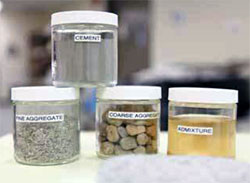To have a sustainable concrete structure, durability is key. Use of inappropriate materials, poor construction practices, curing and mix designs, results in concrete structures often showing serious premature deterioration. This is a global problem that annually costs public and private sectors worldwide billions of dollars.
Measuring the durability of concrete to determine its longevity in service is challenging. It is, however, important in identifying how sustainable structures will ultimately be.
Tests such as water absorption, surface absorption, water permeability, or chloride permeability are commonly specified.
These tests should consider the unique properties of the mix design when used to determine concrete’s durability.
They also have some limitations and it is necessary to understand and recognise them.

Measuring the durability factor of concrete to determine its longevity is difficult to predetermine. It is, however, an important factor in identifying how sustainable the structure will be.
Absorption Tests
Description: Absorption testing is a common method of determining water resistance. Tests such as BS 1881-122:2011 measure the amount of water that penetrates into concrete samples when submersed. Low absorption is a positive result.
Where it’s most useful: The test is intended to determine the susceptibility of unsaturated concrete to water penetration, for both surface and interior concrete.
Limitations:
The absorption test results will improve over time as the crystals continue to grow. Therefore, for crystalline admixtures, testing the absorption at later ages (56 or 90 days) will give more realistic results.

The durability of a concrete mix design is always dependent on the environmental factors of the structure it will be supporting.
Rapid Chloride Permeability test
Description: The Rapid Chloride Permeability (RCP) test is an electrical test used to estimate the durability of concrete. Test methods – like ASTM 1202, Standard Test Method for Electrical Indication of Concrete’s Ability to Resist Chloride Ion Penetration – monitor the amount of electrical charge passed through cylindrical specimens for six hours. The total charge passed, in coulombs, is related to the specimen’s ability to resist chloride ion penetration. Lower levels of charge passed indicate higher resistance.
Where it’s most useful: The RCP test has gained wide acceptance as a relatively easy and quick method for determining concrete permeability.
Overall, this test method is suitable for evaluating materials and material proportions for design purposes, and for research and development.
However, it has incorrectly become one of the tests used to evaluate concrete durability. RCP can qualify a mix, but not necessarily disqualify it.
The RCP test should not be used to accurately determine the permeability of concrete mixes containing supplementary cementitious materials or chemical admixtures.
Limitations: Various drawbacks make the test unreliable, especially for comparing different mix designs or for evaluating concrete durability.
Water Permeability test
Description: BS EN 12390-8 and DIN 1048 Part 5 are equivalent tests measuring depth of water penetration into concrete samples subjected to 0.5 MPa of hydrostatic pressure over three days.
Concrete specimens are cast and cured for 28 days and then placed in the testing device.
The sample holders are open at both ends, with one end subjected to hydrostatic pressure.
After three days, the samples are removed from the testing apparatus, cracked in half vertically and maximum depth of water penetration measured.
Where it’s most useful: This test determines the true permeability of concrete by evaluating concrete’s resistance to penetration of water under hydrostatic pressure and should be the preferred test if concrete is subjected to hydrostatic pressure.
The smaller the depth of penetration, the greater the resistance to water under hydrostatic pressure. This test is useful for basements, tunnels, and water reservoirs, since it realistically recreates pressure conditions to which these structures are subjected.
Limitations:
Conclusion
Environmentally specific mix designs are necessary for every unique condition, as are service-environment-appropriate test
methods.
Absorption tests are best suited to concretes with little or no hydrostatic pressure and permeability tests should be the main test to evaluate concrete subjected to hydrostatic pressure.
The focus of specifications for testing concrete durability should be on determining the concrete’s permeability, resistance to environmental factors, and tendency to crack.
Alireza Biparva, B.Sc., M.A.Sc. Kryton
Research and Development Manager
Email: alireza@kryton.com
Source: Concrete Trends